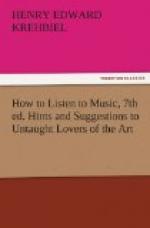“O Lord, rebuke me not
in thy wrath,
Neither chasten me in thy
hot displeasure.”
[Sidenote: Key relationship.]
Here is a period of two members, the latter repeating the thought of the former. A musical analyst might find in it an admirable analogue for the first period of a simple melody. He would divide it into four motives: “Rebuke me not | in thy wrath | neither chasten me | in thy hot displeasure,” and point out as intimate a relationship between them as exists in the Creole tune. The bond of union between the motives of the melody as well as that in the poetry illustrates a principle of beauty which is the most important element in musical design after repetition, which is its necessary vehicle. It is because this principle guides the repetition of the tone-groups that together they form a melody that is perfect, satisfying, and reposeful. It is the principle of key-relationship, to discuss which fully would carry me farther into musical science than I am permitted to go. Let this suffice: A harmony is latent in each group, and the sequence of groups is such a sequence as the experience of ages has demonstrated to be most agreeable to the ear.
[Sidenote: The rhythmical stamp.]
[Sidenote: The principle of Unity.]
In the case of the Creole melody the listener is helped to a quick appreciation of its form by the distinct physiognomy which rhythm has stamped upon it; and it is by noting such a characteristic that the memory can best be aided in its work of identification. It is not necessary for a listener to follow all the processes of a composer in order to enjoy his music, but if he cultivates the habit of following the principal themes through a work of the higher class he will not only enjoy the pleasures of memory but will frequently get a glimpse into the composer’s purposes which will stimulate his imagination and mightily increase his enjoyment. There is nothing can guide him more surely to a recognition of the principle of unity, which makes a symphony to be an organic whole instead of a group of pieces which are only externally related. The greatest exemplar of this principle is Beethoven; and his music is the best in which to study it for the reason that he so frequently employs material signs for the spiritual bond. So forcibly has this been impressed upon me at times that I am almost willing to believe that a keen analytical student of his music might arrange his greater works into groups of such as were in process of composition at the same time without reference to his personal history. Take the principal theme of the C minor Symphony for example:
[Music illustration]
[Sidenote: A rhythmical motive pursued.]
This simple, but marvellously pregnant, motive is not only the kernel of the first movement, it is the fundamental thought of the whole symphony. We hear its persistent beat in the scherzo as well:




